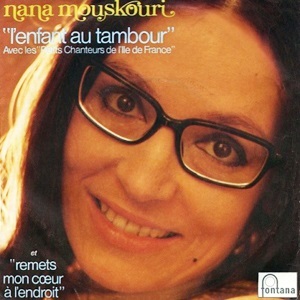
The timeless little drummer boy

It’s not easy to write an article about a song that everyone knows and learns in school. But since this is a Nana classic, it's worth devoting myself to it and understanding why. Who doesn't know "The little drummer boy", this Christmas theme covered by hundreds of performers often accompanied by a children's choir? By recording it, Nana made it one of her essentials. Let us review here its origins, its adaptation and each of its versions: in French, German, Italian, Spanish and English. And, what is the secret of this success?
ORIGINS We owe this melody to the American pianist Katherine Kennicott Davis. When composing it in 1941, she was inspired by the traditional Christmas carol "Patapan" and titled it "Carol of the Drum". It became famous with a recording of Harry Simeone's choir in 1958. Him and producer Henry V. Onorati also received songwriting credits and the song was called from now on "The little drummer boy". The text, almost identical, tells the story of a young boy who finds himself in front of the Nativity scene. He has no gift for the Baby Jesus, but he plays his drum for him. Over the following years, the song was covered by several great performers for their Christmas albums: Johnny Cash, Bing Crosby, Johnny Mathis and many others.
|
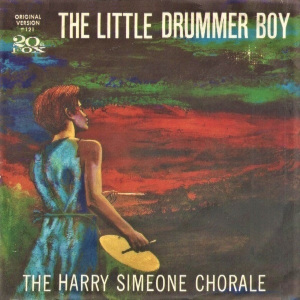 |
|
ADAPTATION When Nana decided to record this modern classic, she first chose the French version, the text of which is signed by the writer Georges Coulonges. For years, she has been moved by the theme: the story of the little child who goes to heaven asking for his father's return. Ultimately, it’s a dream. It must be said that Nana is sensitive to the plight of children in the world and it is no coincidence that she became an ambassador for UNICEF in 1993. The day of the recording, she was accompanied by Michel Legrand's orchestra and the choir of Petits chanteurs de l'Île-de-France. Drum and traverse flute join Nana's voice and those of the choristers to create the mood. The adaptation is successful! |
L’ENFANT AU TAMBOUR This first recording was released in France in May 1965 on her 14th EP. It was also the title of her third LP. There, the song became her second great success in a row after "Les parapluies de Cherbourg". And, in the Francophonie, it was especially popularized by Nana. In Quebec, for example, the 45 rpm was reissued every year for the holiday season. After fifteen years, one can imagine the number of records sold. As the melody is loved by toddlers, in 1971, it was included in her album "Pour les enfants". Over the years, Nana sings it in some television shows and often in her concerts, because it is part of her repertoire. Moreover, in 1997, in New York, for her "Concert for Peace", she chose to perform it in French.
|
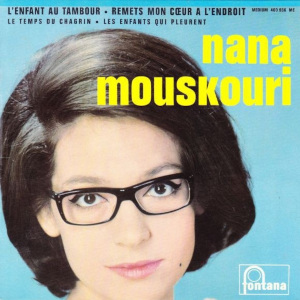 |
|
JOHNNY TAMBOUR In October 1965, "Johnny Tambour" came out on 45 rpm. A few months later, in her second album in German. For this version, the first name Johnny is used to designate the little drummer. Note that there, it is also known under the title of "Der kleiner Trommler". With "Weisse Rosen aus Athen", it is the only song that Nana performed in the national language during her first two German tours in 1972 and 1974. Since then, she has kept it in her repertoire, because she knows that her audience loves to hear it again. In fact, "Johnny Tambour" appeared in her live albums "Eine Welt voll Musik", "Concert '80" and on the DVD "Live in Berlin". |
IL TAMBURINO In December 1965, "Il tamburino" appeared in the album "In Italia", a collection of her songs in Italian. Five months later, on a 45 rpm. As in French and German, it tells the story of a child who dreams of being reunited with his father. Since Nana did not return to Italy often, she did not have the opportunity to perform it in front of an audience. On the other hand, the song achieved some success, because the sheet music was marketed. There too, this melody has been covered by a multitude of performers and choirs in the national language. The lyrics differ depending on the version. |
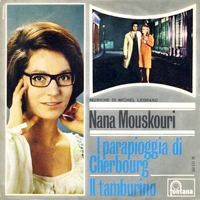 |
|
EL PEQUEÑO TAMBORILERO The Spanish version was published on an EP in May 1966. Its text is similar to the original by evoking the king, Jesus, Mary, the angels and the crib. Despite the fact that Nana didn't speak yet the language, the recording is excellent. It could even have been included in a Christmas compilation, for example. But since it didn't appear on a LP, it was forgotten. During her twenty years of absence in Spain, it was especially the singer Raphäel who popularized it. Nana's recording will be available again in 2008 in her Spanish Integral. |
THE LITTLE DRUMMER BOY It took years for Nana to record it in English, because she rarely covers a song in the language in which it was popularized. But for the purposes of a Christmas album in 1972, "The little drummer boy" was an essential. If in her concerts, Nana chooses not to perform it in the original version, it is undoubtedly because it is identified with the fest of Christmas. Indeed, the text refers to the new born king, Mary, the ox and the lamb. However, her recording has been widely marketed as it can be found in several compilations. As for the album "Christmas with", it appeared in some 20 countries and brought her several gold and platinum records. |
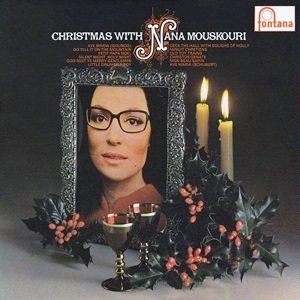 |
|
THE SECRET OF THIS SUCCESS When an artist records five versions of a song, each in a different language, it is no accident. Nana chose a simple and rhythmic melody that appeals to young and old alike. To follow it, just repeat its famous onomatopoeia: "parapapampam". However, the interpretation that people like to hear is Nana's. In the studio, it is perfect. But on stage, it is even more poignant, especially for the segment where drums, bass and guitars gain in intensity: "Tous les anges ont pris leur beau tambour" (All the angels have taken their beautiful drum). The emotion is at its height and the spectators are delighted. There is no secret. Nana owes this success to her qualities as a performer. |
AN ESSENTIAL
Almost all singers record Christmas tunes, but few make successes with which we indentify them. With the famous drummer boy, Nana made it a timeless song. Whatever the time of year, she includes it in her singing recitals. For Nana, there is no fixed period for singing a child's dream. This lasts for more than 50 years. And each time, her interpretation is always so fresh. This is why "The little drummer boy" became an esencial.